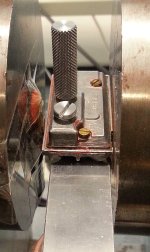RF technique and Electron-Paramagnetic Resonance (EPR)
Supervisor: Dr. S. Vogt
 The fundamentals of electron-paramagnetic resonance (EPR) are
mediated by means of a simple measuring arrangement.
The dispersion signal of the resonance effect is measured on DPPH and Ultramarin samples of different dilution degrees.
The resonance frequencies and the resonance curve shapes of both substances are determined. We go as far as the detection
limit of the spectrometer.
An X-band resonator is used. The signal is recorded using Software Defined Radio (SDR).
This consists of a hardware, the radio signal processor (RSP) and a software (HDSDR) for the spectral representation
and recording of the measurement results.
The experiment is intended to show that the determination of the electron spin resonance is quite comparable to
"listening to the radio". Therefore, we begin with some basic experiments from the RF technique.
The fundamentals of electron-paramagnetic resonance (EPR) are
mediated by means of a simple measuring arrangement.
The dispersion signal of the resonance effect is measured on DPPH and Ultramarin samples of different dilution degrees.
The resonance frequencies and the resonance curve shapes of both substances are determined. We go as far as the detection
limit of the spectrometer.
An X-band resonator is used. The signal is recorded using Software Defined Radio (SDR).
This consists of a hardware, the radio signal processor (RSP) and a software (HDSDR) for the spectral representation
and recording of the measurement results.
The experiment is intended to show that the determination of the electron spin resonance is quite comparable to
"listening to the radio". Therefore, we begin with some basic experiments from the RF technique.
- Frequency mixing and modulation
- Receiving and analyzing signals in the VLF range from 10 kHz to 150 kHz
- Reception of FM broadcasts and selected signals in the VHF and UHF range and their assignment
- Determination of the resonance frequency and recording of the dispersion curves of different DPPH samples
- Determination of the resonant frequency and recording of the dispersion curves of different Ultramarin samples

